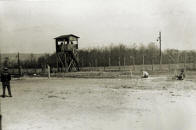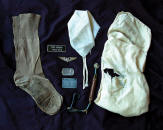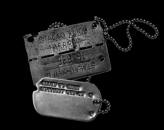The prison that inspired a movie and a TV comedy was a dingy, fleabag patch of hell for the Allied "kriegies" who got stuck there.
By Eric Ethier
In the middle of the beautiful Austrian countryside of rolling hills and thick forest stood an ugly place—the sprawling eyesore and den of misery known as Stalag Luft 17-B. Double rows of barbed-wire fencing surrounded low-slung prison barracks and a dirt compound. Helmeted Nazi guards with machine guns manned towers at the edges, waiting to shoot dead any prisoner who crossed the warning wire that ran a few feet inside the fencing. To some of the underfed, ailing, and depressed POWs forced to live there—many of them American airmen—sudden death by enemy gunfire must at times have seemed a reasonable alternative.
 The terrible truths tucked away with Stalag 17-B in the Austrian wilderness began to come to light in the spring of 1945, as Russian armies from the east and American armies from the west were crushing the remnants of the Nazi war machine between them. Territories captured from the Germans were beginning to give up all sorts of ugly secrets about Adolf Hitler’s dying Third Reich. As General George S. Patton’s Third Army smashed its way across Germany toward Austria, it began liberating thousands of German captives—Hitler’s starving, mostly Jewish political prisoners and captured Allied soldiers and airmen. As elements of Patton’s 13th Armored Division blasted their way into Austria, they found several groups of chilled, ashen-faced Americans in the woods near Braunau. They were refugees from the infamous stalag near Krems, Austria, 280 miles to the east.
The terrible truths tucked away with Stalag 17-B in the Austrian wilderness began to come to light in the spring of 1945, as Russian armies from the east and American armies from the west were crushing the remnants of the Nazi war machine between them. Territories captured from the Germans were beginning to give up all sorts of ugly secrets about Adolf Hitler’s dying Third Reich. As General George S. Patton’s Third Army smashed its way across Germany toward Austria, it began liberating thousands of German captives—Hitler’s starving, mostly Jewish political prisoners and captured Allied soldiers and airmen. As elements of Patton’s 13th Armored Division blasted their way into Austria, they found several groups of chilled, ashen-faced Americans in the woods near Braunau. They were refugees from the infamous stalag near Krems, Austria, 280 miles to the east.
The refugees were sergeants of the US Army Air Forces, most of whom had begun their lives under the Nazi boot the same way. During missions over German cities such as Bremen and Stuttgart and other Nazi strongholds, their B-17 Flying Fortresses and B-24 Liberators had been shredded by German fighters or anti-aircraft guns, sending them tumbling through the sky, fumbling with parachutes and praying for survival. Captured on the ground, the American pilots, bombardiers, flight engineers, and assorted gunners and other crewmen were first funneled into a processing center, Dulag Luft, near Frankfurt, Germany, for interrogation. There, German Luftwaffe (air force) officers separated the commissioned officers from the non-commissioned officers and shipped them to other depots of the German prison camp system (except for chaplains and doctors, who might be assigned among enlisted prisoners). The non-commissioned officers were then packed like cattle into filthy boxcars and shipped by rail to their new homes and lives as prisoners of war.
At Stalag 17-B, one of the most notorious German prisoner-of-war camps, the American fliers were herded from the train to the bleak outpost about a mile or so away. They were quickly processed—deloused, shaved, and assigned a number—and released into the wide compound to find a bed in one of the barracks. To free-spirited airmen accustomed to seeing only the pastoral outlines of the German landscape or the tops of cities, the ominous, tightly-pressed surroundings were troubling.
Initially used to detain the hapless prisoners of Germany’s early blitzkriegs, Stalag Luft 17-B (Stalag Luft, short for Stammlager Luft, or prison camp for airmen, and 17-B because it was the second prison camp in the German 17th military district) was opened to American POWs in 1943. The camp’s American population soon swelled to more than 4,200 as the United States and Great Britain intensified their strategic bombing campaign.
The American veterans shared their misery with more than 25,000 neighbors. Their section of the camp was flanked by international compounds stuffed with French, Italian, British, and other Allied prisoners—and a ghastly village of the damned saved for the Russians. Detested, feared, and treated worse than animals by the Germans, Russian prisoners suffered beyond comprehension. The Nazis ignored sickness and starvation in the Russians’ ranks, and men died in droves. Desperately hungry, during the winter months, Russian prisoners propped up dead comrades in their lines for roll call each morning to be counted by unknowing Germans, who issued rations based on a shoe count. Russia had not signed the 1929 Geneva Convention agreement, which, on paper, guaranteed humane treatment for prisoners of war. Western captives at least had that agreement working in their favor, and the American fliers even received a semblance of respect from a few of the German air force officers who guarded them—though they got no sympathy from Commandant Oberst Kuhn, an army officer.
 If the hell inflicted on the Americans was different from the hell inflicted on the Russians, it was only by degree—especially during the war’s final months. A series of long, single-story buildings housed the fliers. Each one was divided into halves shared by 150 to 240 men (and sometimes many more), who also shared straw-filled, flea-ridden mattresses in triple-deck bunks, a single stove with scant fuel (54 pounds of coal per week), wash basins into which cold water ran only a few hours each day, and a single indoor latrine for use after dark (for daytime use, there were multi-hole latrines a short walk from the barracks). Hot water and showers were as rare as toothbrushes, combs, and toilet paper. Together with diarrhea and dysentery, the poor hygiene made life at Stalag 17-B precarious.
If the hell inflicted on the Americans was different from the hell inflicted on the Russians, it was only by degree—especially during the war’s final months. A series of long, single-story buildings housed the fliers. Each one was divided into halves shared by 150 to 240 men (and sometimes many more), who also shared straw-filled, flea-ridden mattresses in triple-deck bunks, a single stove with scant fuel (54 pounds of coal per week), wash basins into which cold water ran only a few hours each day, and a single indoor latrine for use after dark (for daytime use, there were multi-hole latrines a short walk from the barracks). Hot water and showers were as rare as toothbrushes, combs, and toilet paper. Together with diarrhea and dysentery, the poor hygiene made life at Stalag 17-B precarious.
Inside their spartan quarters, prisoners searched for fellow crew members whom they had last seen inside a falling, shot-up plane, and acquainted themselves with the other men of their “bay” (a tightly clustered section of bunks that lined the barracks walls). Many of the new “kriegies” (short for the German kriegsgefangene, or prisoner of war) paired up in “combines” as a way of looking out for one another. Each barracks became a sort of autonomous unit. Within that realm, individual bays became close-knit groups—men bound together by circumstance, hatred of the Nazis, and the common fight for survival.
New arrivals were often surprised to discover a system of government in the American compounds—a democratically elected power structure headed by a so-called Man of Confidence (MOC). In Stalag 17-B this MOC was Staff Sergeant Kenneth Kurtenbach, a tough, intelligent, and resourceful sergeant who represented the prisoners in any dealings with their German captors. Each barracks had its own elected leader, who reported to Kurtenbach and his security team in a barracks building referred to as the White House. Kurtenbach knew how to get things done, spoke German, and had final say on all prisoner matters, including—and especially—escape attempts.
According to the Geneva Convention, as non-commissioned officers, the Americans were not required to work. So, they filled their days with chat, occasional visits to the camp’s makeshift library, exercise, and thoughts of how to stay a step ahead of hunger, depression, and the guards. They might have laughed at the comfortable picture of their lives sometimes portrayed by the American press. During visits to two other stalags in early 1944, a YMCA official saw Red Cross packages that were given to soldiers. “There is an average of one parcel a week for each man,” he claimed, “and they are so well prepared that the men have requested the Germans to limit their provisions to bread, potatoes, and hot water.” Prisoners told a different story. If a man could live on that parcel for a week, one of them wrote, it was only “at ten percent over starvation.” Contents of the shoebox-size parcels generally included canned tuna, cheese, dehydrated milk, liver paste, and raisins, along with margarine, sugar, several packs of cigarettes, and two D-Bars (condensed chocolate). The German camps were expected to stock enough of the parcels to provide one week of sustenance for each American. In reality, many Red Cross crates disappeared en route. One prisoner remembered receiving just a single box during the war’s final eight months.
Prisoners often bartered with one another for supplies. “One of the amusing activities of the camps is the bargaining that goes on between prisoners for things they need or want,” wrote a New York Times reporter in March 1944. The truth was that at most camps—especially the harsher ones such as Stalag 17-B—bartering between prisoners and even guards was serious business, sometimes a matter of survival. The most prized trading commodities were cigarettes and D-Bars. For the quickly thinning American ranks, the average daily menu—which German officials, not the prisoners, chose to reduce when Red Cross parcels were distributed—consisted of warm water in the morning (which many men used to make coffee), a few crusts of dark bread of dubious preparation in the afternoon, and a dinner of pitifully thin soup of perhaps potato or rutabaga, but more often fish heads and other assorted discards. “The ingredients used for our meals soon convinced me that the best way to eat was to sit in a dark corner of our barracks and not think about what I was eating,” Kriegie William E. Rasmussen recalled. In the end, as their waistlines shrank, Kriegies downed anything that would fill their stomachs.
 While prisoner interaction with German overseers was generally limited to the twice-daily roll calls and an occasional barracks sweep, guards were sometimes brutish, and the shadow of death lingered over the camp. In 1943 three Americans were killed under suspicious circumstances. The following year, quick-trigger guards shot an unbalanced Kriegie who ran screaming across the compound one night. His body lay sprawled across the fence until the morning as a warning to his shaken fellow prisoners. A postwar inquiry found that in less than two years of American captivity, there were “about 30 recorded cases of guards striking PW [POWs] with bayonets, pistols, and rifle butt. Protests to the commandant were always useless.” Ned Handy, a flight engineer from Massachusetts, described one such run-in with one of the camp’s more notorious guards:
While prisoner interaction with German overseers was generally limited to the twice-daily roll calls and an occasional barracks sweep, guards were sometimes brutish, and the shadow of death lingered over the camp. In 1943 three Americans were killed under suspicious circumstances. The following year, quick-trigger guards shot an unbalanced Kriegie who ran screaming across the compound one night. His body lay sprawled across the fence until the morning as a warning to his shaken fellow prisoners. A postwar inquiry found that in less than two years of American captivity, there were “about 30 recorded cases of guards striking PW [POWs] with bayonets, pistols, and rifle butt. Protests to the commandant were always useless.” Ned Handy, a flight engineer from Massachusetts, described one such run-in with one of the camp’s more notorious guards:
After dressing, I was the last out, trailing the others, when suddenly I was grabbed by my left arm and yanked about ten feet to a little shed. I was thrown through its rickety door before I could even react. My attacker was strong and he spun me around. It was Max…. He drew a large pistol from his holster, moved the barrel to his right hand and swung its heavy butt hard into my head. He hit me two or three more times before I blacked out.
Handy exacted a measure of revenge by facilitating the only successful escape from Stalag 17-B. In January 1945, he swapped identities with Frank Grey, an American POW wanted by the Gestapo for prior escapes, and helped Grey slip away. Grey ultimately reached Yugoslavia, where anti-Nazi partisans assisted him. Half a century later, Handy would recount this event and many others in his powerful memoir The Flame Keepers.
Escape was a topic rarely discussed aloud in camp. Beyond the imposing barbed wire, the broad Austrian countryside separated any escapee from freedom. Prospects for success—such as the mass breakout that occurred at Stalag Luft 3 in March 1944—were poor. Grey managed the improbable only through a series of rendezvous with contacts who helped him make his way through Yugoslavia. Still, the resourceful American captives of Stalag 17-B attempted to dig a number of tunnels, using scoops fashioned out of aluminum cans and other items.
The prisoners focused most of their creative energies on making their lives more bearable. Pilfered shingles and other scraps of wood went into the stove or were used to make tools. Aluminum cans that held klim (dehydrated milk) were turned into everything from drinking cups and eating utensils to miniature lanterns and improvised spigots for sinks. Enterprising airmen even managed to build at least one radio from crystal, headphones, and a few other items snuck into camp. So enabled to monitor the progress of the war, kriegies knew when the end was near.
Even without a radio, though, the Americans at Stalag 17-B could tell something was happening in April 1945. American planes appeared overhead almost daily, while thunderous flashes of light to the east confirmed the approach of Russians seeking vengeance for atrocities the Germans had committed on them earlier in the war. Across eastern Germany the Nazis had already begun death marches, herding thousands of suffering political prisoners and Allied captives west toward approaching American forces, from whom the Germans expected better treatment than from the dreaded Red Army.
Finally, the Americans of Stalag 17-B were told to gather their meager possessions and prepare to move out. On April 8, 1945, the gates of the American compounds swung open, and 4,000 filthy, scrawny, and hungry airmen stumbled out onto the road west. (About 200 sick prisoners stayed behind, and were liberated by Russians on May 9.) If the men were relieved to be out of their pen, they quickly discovered that life on the march was no better, or safer.
Days passed slowly as the men struggled along in eight groups of 500 each—hesitant to stop to drink from a nearby stream or even to relieve themselves for fear of the guards’ rifle butts and bayonets. Feet crammed into worn-out leather boots or camp-issued wooden clogs swelled, bled, and blistered. Only the nearness of freedom drove many on. When it didn’t rain or snow, nighttime brought some relief from pain, as the men lay their tired bodies down to sleep in the woods and fields along the winding country roads. Food remained scarce. Guards provided little more than a few uncooked potatoes. At night, healthier prisoners prowled nearby fields and farms for anything edible. Back on the road early each morning, the columns dodged increasing numbers of rumbling German vehicles, and the wide-eyed Americans stared in horror as they passed living skeletons in striped pajamas with yellow stars on them. It was their first encounter with Nazi Germany’s tormented, mostly Jewish political prisoners.
Perhaps three weeks later, guards halted the four-mile-long column and ordered the Americans to make camp among the tall pines of the Leach Forest. There, in hastily improvised shelters, the men shivered, waiting for deliverance. Finally, as May dawned, relief arrived in the rugged jeeps and hulking Sherman tanks of the 13th Armored Division. The gaunt prisoners felt lucky to see the men known as the Black Cats. Their long ordeal was over.
Within days of the rescue, American forces began uncovering the ghastly results of Hitler’s Final Solution—human slaughter pens filed with the remains of thousands of Jews and other people Nazis considered undesirable and unworthy of life. As Handy later wrote, “We know now what none of us could have imagined then: that those who shuttled us in boxcars to Stalag 17 routed millions of others to the death camps.” Doubtless other American prisoners of Stalag 17-B also discovered themselves counting their blessings as they pondered their plight in one of the Nazis’ harshest prisons. Although they had lived through hell, they lived.
Middle photo: Some personal items that belonged to Paul "Flash" Gordon, a B-17 ball-turret gunner with the US 327th Squadron, 92nd Bomb Group, while he was at Stalag 17-B.
Bottom photo: The prisoner’s tag (above) and dog tag of Stalag 17-B prisoner Lloyd Kern, a B-17 ball-turret gunner with he US 303rd Bomb Group, known as Hell’s Angels.
Copyright 310 Publishing, LLC. All rights reserved.


FOLLOW US »
